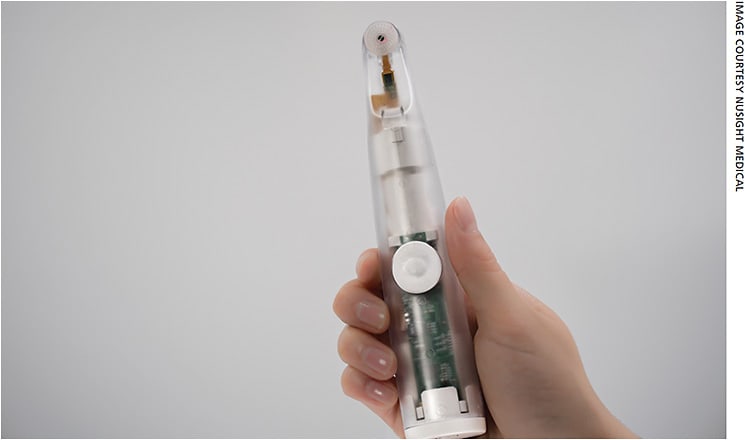This at-home treatment device gets around patient compliance issues.
Truth be told, no matter how often ophthalmologists recommend proper lid hygiene methods, including hot compresses and lid scrubs, to their dry eye disease (DED) and meibomian gland dysfunction (MGD) patients, most of them are not compliant. In a 2014 self-reporting compliance study conducted at a Veterans Affairs eye clinic published in Eye & Contact Lens in 2017, only 104 out of 188 patients (55%) reported that they were compliant with their prescribed lid hygiene regiment after six weeks. Even if patients use lid scrubs, they may not follow the recommended directions appropriately and abandon the treatment as ineffective, according to the original TFOS DEWS report. Novel in-office treatments and devices that heat and massage the meibomian glands to remove blocked caps and melt congealed meibum are very effective, but what does the patient do between visits to keep inspissated meibum at bay?
NEW LIDS WITH NULIDS
The NuLids System (NuSight Medical), a hand-held device recently approved by the FDA, is an at-home treatment for MGD, analogous to an electric toothbrush, “used at home between deep cleanings and regular visits to your dentist,” according to James Laux, chief commercial officer at NuSight.
According to the company’s website, NuLids is used for 60 seconds a day, 15 seconds per eyelid, to gently and methodically massage the lids, removing collarettes and decapping blocked meibomian glands, allowing the meibum to run clear. The result is decreased tear evaporation, a reduced dependence on artificial tears and fewer symptoms and signs of DED, the company says. The device is prescribed and purchased through an eye-care professional at a list price of $319 and comes with a 30-day supply of disposable tips.3 Additional tips are ordered by the patient directly from NuSight for $1 apiece.
A drop of ocular lubricant is applied to the NuLids tip prior to use. If the meibomian glands are only mildly blocked, the suggested drop may be a viscous ocular gel or a gentle non-exfoliating, non-oily cleanser. When the patient has a more significant case of blepharitis or Demodex, a hypochlorous solution may be indicated by the doctor. “No gel, solution and/or lubricant is sold or recommended by NuSight Medical,” Mr. Laux says. “The choice of lubricant is at the doctor’s discretion, which is precisely why we say that the NuLids System is a doctor-prescribed, at- home daily therapeutic treatment.”

SO HOW EFFECTIVE IS IT?
The company-sponsored NuLids II Clinical Study of 74 eyes of 37 subjects who used the NuLids System at home, together with a hypochloride solution for 30 days, showed a statistically significant improvement in ocular surface disease index, tear osmolarity — from 315 ± 15/7 to 306 ± 13.9 — and tear break-up time — from pretreatment 4.8 ± 1.7 seconds to post-treatment of 7.9 ± 4.1 seconds. Meibomian gland score improved, too, from 8.9 ± 5.1 to 7.0 ± 5.9, as well as meibomian yielding liquid secretion and sicca ocular staining score, from 2.7 ± 2.1 to 1.4 ± 1.5. No adverse events or ocular trauma were reported. Further, 91% of subjects agreed or strongly agreed that the device was easy and convenient to use, and 95% were satisfied or very satisfied with the overall treatment effect.
NULIDS IN PRACTICE
Julio Echegoyen, MD, a cataract, corneal and anterior segment physician and surgeon from San Diego affiliated with VA San Diego Healthcare System, has used NuLids in practice and personally. The unit head oscillates and vibrates to improve the flow of meibum, he says. “Most people notice favorable results in a week to 10 days.”
Personally, he noticed less ocular itching and irritation after only five days of using NuLids. “It is very easy to massage the lower lid. For the upper lid, a patient needs to be dextrous enough to hold the lashes up while looking down so the lid margin flips outward, exposing the meibomian glands, without the device rubbing the conjunctiva.”
The learning curve for patients to achieve this is approximately a week, Dr. Echegoyen discovered. He added that his practice has not experienced incidences of corneal abrasions or other injuries or complications in his practice, because the tip of the device is soft and gentle.
Dr. Echegoyen still prescribes cyclosporine and artificial tears and and uses in-office treatments for MGD for initial management and difficult cases. He notes that in-office devices can be uncomfortable for patients due to the lid squeezing necessary to clear blocked glands. With respect to at-home treatments with the NuLids system, he recommends using hot compresses beforehand to help dissolve the meibum, making the device even more effective. “The hypochlorous solution stings at first,” Dr. Echegoyen says, “but it gets better with time. I still personally need to use Xiidra [Shire] twice a day, but I’ve been able to significantly reduce my use of Celluvisc [Allergan].”
CONCLUSION
Dr. Echegoyen is inspired by the outcomes he has experienced with the NuLids System and looks forward to continuing to distribute the device to his patients. “Just like with dental hygiene, including electric toothbrushes and flossing, ocular hygiene will have to become a habit,” he says. “Encourage patients to keep the device in the bathroom and use it daily, as prescribed. The benefits will be evident at their next eye exam.” OM








